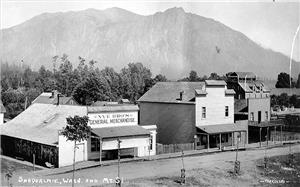Snoqualmie, a rural community founded early in the Puget Sound region's history, is located about 30 miles east of Seattle along the Snoqualmie River just above Snoqualmie Falls.
Father of the Snoqualmie Valley
The three forks of the river converge near the town to form Snoqualmie Falls, a spectacular 276-foot waterfall. The Snoqualmie Tribe considers the falls to contain powerful magic for peace. When non-Native settlers reached the area in the 1850s, Snoqualmie Chief Patkanim sided with them against competing tribes. It was Chief Patkanim who signed the Point Elliott Treaty in 1855, ceding all of the tribe's land to the United States. But the U.S. never repaid the Tribe and never gave it a reservation. Many of the Snoqualmie ended up living in poverty on land that was once theirs.
The signing of the treaty did open up the land for homesteaders. The Kellogg brothers are thought to be the first new settlers in the Snoqualmie Valley, but they only stayed for a few years. Jeremiah Borst (1830-1890) is considered by many to be the first permanent settler near the falls. He arrived in 1858. He had made enough money in the California gold rush to move to Washington and buy land, which he did with fervor. By the 1880s, he was far and away the wealthiest man in the valley. Borst had three consecutive Indian wives, the last of whom was Kate Kanim Smith, a relative of Patkanim. She was also a distant relative of Chief Seattle. Kate Borst was well respected in the surrounding communities. Over the years she made many friends and always enjoyed discussing the many changes she had witnessed over her lifetime.
As Jerry Borst was buying up land, so were many others. The lumber along the mountainsides provided jobs for loggers and the valley was profitable for farmers. Many tales are told about Lucinda Fares, a niece of Borst. "Lucindy" was a large woman with a heart of gold. Many travelers stayed overnight at her farmhouse, partaking in her pioneer hospitality. One time, she adopted a young boy who was abandoned by his parents while passing through. Since Lucindy weighed almost 350 pounds, milking cows on her farm proved to be quite a chore for her. Instead of moving from cow to cow, she trained all 30 of them to come to her when called by name. Pioneers remembered the sight of each cow lining up one after the other to be milked.
Pioneer Life
Life in the rural community was a challenge, especially for young children. Many children received education from people with dubious credentials. The first teacher in the area, Asa Storey, taught out of his wretched shack, and his own children were described as wild things of the woods. The second teacher, Al Fiske, once insisted to his pupils that two times zero was two, three times zero was three, and so on. The students rebelled. They got up, walked out of class, and went home. Another teacher left after young girls in the class soundly beat him up for whipping a young boy.
During the 1880s, hop farming was very successful in the valley. Many hop-pickers were Native Americans who came from all over the Northwest to work at the hop ranch. Lumber mills were another successful industry, surviving long after aphids wiped out the hop crops near the turn of the century.
Growth and Expansion
Railroad service reached the upper valley in 1889. The first train was an excursion train, indicative of the area's charm as a tourist destination. Accessibility to Puget Sound also made Snoqualmie a desirable place to live. In 1870, fewer than 50 people inhabited the entire valley. By 1900, Snoqualmie alone had 429 residents. Three years later those residents voted to organize their own local government, and Snoqualmie incorporated as a town of the fourth class on June 9, 1903.
Throughout the twentieth century, the lumber industry continued to operate, but became less important to the economic health of the community. Proximity to the spectacular waterfall and to Snoqualmie pass made the community a popular stop for visitors, either by train or by road. When Highway 10 (precursor to today’s I-90) was built in the 1940s, it bypassed Snoqualmie and the town initially suffered a loss of tourism, but over time community leaders shored up the image of the town as a worthy destination for travelers. Even without the rail line, which was abandoned in 1974, Snoqualmie remains a pleasant, peaceful community, due in part to the magical powers of the falls.

